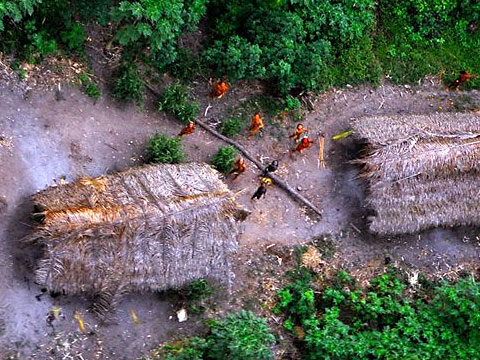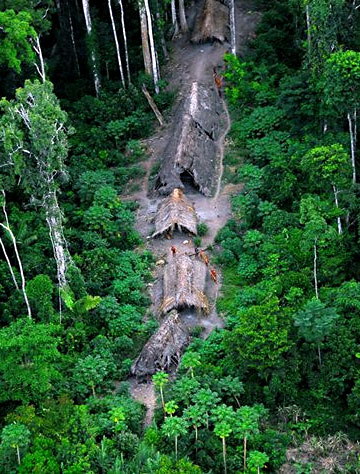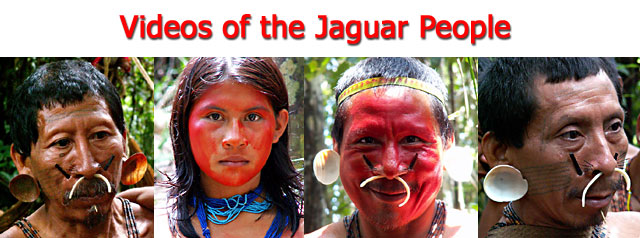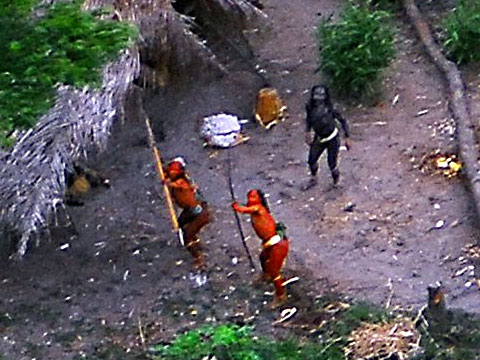ecently, the Brazilian
government released photographic evidence that uncontacted Amazonian natives
still exist in the area of the Peruvian border with Brazil. What makes these
images particularly intriguing is their high quality, revealing much of this
newly discovered tribe’s culture, and the verification of reported encounters by
the Matsés tribe of uncontacted natives that have long hair, the Cabellos
Largos.
The Matsés tribe has many hunting camps scattered in and around their lands in
Peru and Brazil in the Javari River Valley. These hunting camps are only
occupied for several months out of the year and usually have huts and cultivated
gardens with indigenous crops such as plantains and cassava. Recently, the
Matsés have reported several encounters of long-haired uncontacted natives who
have been harvesting some of the Matsés gardens at these isolated hunting camps
in the southernmost range of their territory in Peru. None of the males of
previously contacted tribes in the Javari Valley sport long hair. In fact,
tribes such as the Matsés, Matis, Korubos and Marubos are renowned for having
very short hair. Hence, the Matsés referring to this uncontacted tribe as the
Cabellos Largos, or the “Long-Haired People.”
 The
newly released photographs of these uncontacted natives clearly show the manner
in which they use body paint to decorate their face and bodies. In fact, their
use of red dyes on their face is similar to the traditional body paint of the
Matsés tribe. Both Matsés males and females use red paint derived from the fruit
of the annatto tree (Bixa orellana), in order to dye the skin around the
eyes a bright red color. Similarly, the use by these previously uncontacted
Amazonian Indians to paint the entire body of the female black with a dye
obtained from the genipap tree (Genipa americana) is presently practiced
by the Ticuna tribe during their coming of age ritual, the Pelazon, in which the
Ticunas paint the entire bodies of adolescent girls black. The
newly released photographs of these uncontacted natives clearly show the manner
in which they use body paint to decorate their face and bodies. In fact, their
use of red dyes on their face is similar to the traditional body paint of the
Matsés tribe. Both Matsés males and females use red paint derived from the fruit
of the annatto tree (Bixa orellana), in order to dye the skin around the
eyes a bright red color. Similarly, the use by these previously uncontacted
Amazonian Indians to paint the entire body of the female black with a dye
obtained from the genipap tree (Genipa americana) is presently practiced
by the Ticuna tribe during their coming of age ritual, the Pelazon, in which the
Ticunas paint the entire bodies of adolescent girls black.
Another characteristic of this newly discovered Amazonian tribe that is similar
to the Matsés is their use of headbands (coronas) and waist belts made
out of undeveloped leaves of the Huicungo Palm (Astrocaryum murumuru) . The
Matsés are one of the few Amazonian tribes that use wide headbands similar to
those used by this uncontacted tribe. In addition, the photos clearly
reveal the use of thick waist belts similar to the traditional belts used by the
Matsés. In contrast, the Matis and Korubo tribes use a thin cord to support
their male members.
Interestingly, these newly released photos reveal that this recently discovered
tribe grows and harvests cotton, as do the Matsés. The Matsés use cotton to
weave various textiles such as women’s skirts, wrist and leg bands (pulseras),
and in the manufacture of arrows. Additionally, the aerial photographs of these
previously unknown Amazonians clearly show that they are cultivating cassava (Manihot
esculenta) an edible tuber in the spurge family (Euphorbiaceae). Cassava is
commonly cultivated in the Amazon for its tuberous roots, from which is derived
a flour used for making bread, and tapioca. In addition, an alcoholic beverage (masato)
is derived from cassava.
 The
houses of these uncontacted natives are rather small and unlike the large,
traditional long houses (malokas) of the Matsés, Matis, and Marubos in
which up to one hundred individuals lived. Their small huts seem to be more like
the Korubos and may indicate that this newly discovered tribe is rather small or
at least this particular village has few individuals living in it. The
houses of these uncontacted natives are rather small and unlike the large,
traditional long houses (malokas) of the Matsés, Matis, and Marubos in
which up to one hundred individuals lived. Their small huts seem to be more like
the Korubos and may indicate that this newly discovered tribe is rather small or
at least this particular village has few individuals living in it.
Perhaps the most striking characteristic shown in these newly released images is
their use of bows and arrows. All the major tribes (e.g. Matsés, Matis,
and Marubos) in the Javari Valley traditionally used bows and arrows with the
exception of the Korubos who use blowguns and war clubs. The prominent display of bows and
arrows by this uncontacted tribe raises the possibility that this is the tribe
referred to by the Matis as the “Flecheiros” (in Portuguese) or “Arrow People,”
a bow and arrow using tribe whose expedition to find them was featured in an
article by Scott Wallace in the August, 2003 issue of National Geographic
Magazine. However, the possibility is remote as the "Flecheiros" live
in the headwaters of the Itaquaí River, near the Jutaí and Jantiatuba rivers,
while the images of this newly discovered tribe were taken far away to the south in
the upper Envira river area. Hence, it is plausible that they could be
"Flecheiros" but most likely are a distinct tribe.
Curiously, several weeks after the release of the photographic proof of the
existence of this uncontacted or "lost tribe," some journalists started calling
this new tribe a hoax and called them the "Not-So-Lost tribe."
By quoting the
photographer of these photos (José Carlos Meirelles) as saying that scientists
have known about this specific tribe since 1910, they alleged that Meirelles and
the Brazilian government released the pictures to make them seem like a lost tribe in order to
bring attention to the dangers
that loggers might have on uncontacted indigenous Amazonians. Using logic
such as this is faulty in that whether this tribe is known or unknown to
scientists is immaterial; this tribe is living isolated from the rest of the
world and is obviously uncontacted. Moreover, no one knows what they call
themselves, what language they speak or their relationship to other tribes.
According to the National Geographic writer Scott Wallace, "My
colleagues in the press didn't understand it when they rushed to publish the
photos and they don't understand it now when they call the photos a hoax. These
people are for real, they remain uncontacted. Just because the Brazilian
government has known that they've been there doesn't make them any less real or
any less uncontacted."
Now that proof that the
Cabellos Largos actually exist has been released, it is time to protect this
uncontacted tribe and their way of life. Unknown to most Peruvians, the Peruvian
government is selling oil concessions to foreign oil companies of all the land
in the Javari Valley on the Peruvian side of the border. In fact PeruPetro, a
governmental corporation, recently sponsored a convention in Houston, Texas in
which they presented the oil blocks that they are selling as uninhabited
territories, a clear misrepresentation as it is known that uncontacted tribes
and the Matsés live in this area. This raised the distinct possibility that the
survival of Cabellos Largos and the Matsés tribe will be put in jeopardy
by the invasion of their territory by these foreigners. Rather than sell the oil
concessions for the benefit of foreign oil companies and the shareholders of
PeruPetro, it would prudent for the Peruvian people to demand that the Peruvian
government allow the Matsés and Cabellos Largos to be the guardians of
their land and preserve it as they have for millennia.
The author, Dan James Pantone, is the founder of the Movement in the Amazon for Tribal Subsistence and
Economic Sustainability (MATSES). For more information on how you can help the
Matsés tribe and the Cabellos Largos in their struggle against these
foreign oil companies that are invading their territory, please visit www.matses.org.

|


 The
newly released photographs of these uncontacted natives clearly show the manner
in which they use body paint to decorate their face and bodies. In fact, their
use of red dyes on their face is similar to the traditional body paint of the
Matsés tribe. Both Matsés males and females use red paint derived from the fruit
of the annatto tree (Bixa orellana), in order to dye the skin around the
eyes a bright red color. Similarly, the use by these previously uncontacted
Amazonian Indians to paint the entire body of the female black with a dye
obtained from the genipap tree (Genipa americana) is presently practiced
by the Ticuna tribe during their coming of age ritual, the Pelazon, in which the
Ticunas paint the entire bodies of adolescent girls black.
The
newly released photographs of these uncontacted natives clearly show the manner
in which they use body paint to decorate their face and bodies. In fact, their
use of red dyes on their face is similar to the traditional body paint of the
Matsés tribe. Both Matsés males and females use red paint derived from the fruit
of the annatto tree (Bixa orellana), in order to dye the skin around the
eyes a bright red color. Similarly, the use by these previously uncontacted
Amazonian Indians to paint the entire body of the female black with a dye
obtained from the genipap tree (Genipa americana) is presently practiced
by the Ticuna tribe during their coming of age ritual, the Pelazon, in which the
Ticunas paint the entire bodies of adolescent girls black.  The
houses of these uncontacted natives are rather small and unlike the large,
traditional long houses (malokas) of the Matsés, Matis, and Marubos in
which up to one hundred individuals lived. Their small huts seem to be more like
the Korubos and may indicate that this newly discovered tribe is rather small or
at least this particular village has few individuals living in it.
The
houses of these uncontacted natives are rather small and unlike the large,
traditional long houses (malokas) of the Matsés, Matis, and Marubos in
which up to one hundred individuals lived. Their small huts seem to be more like
the Korubos and may indicate that this newly discovered tribe is rather small or
at least this particular village has few individuals living in it. 